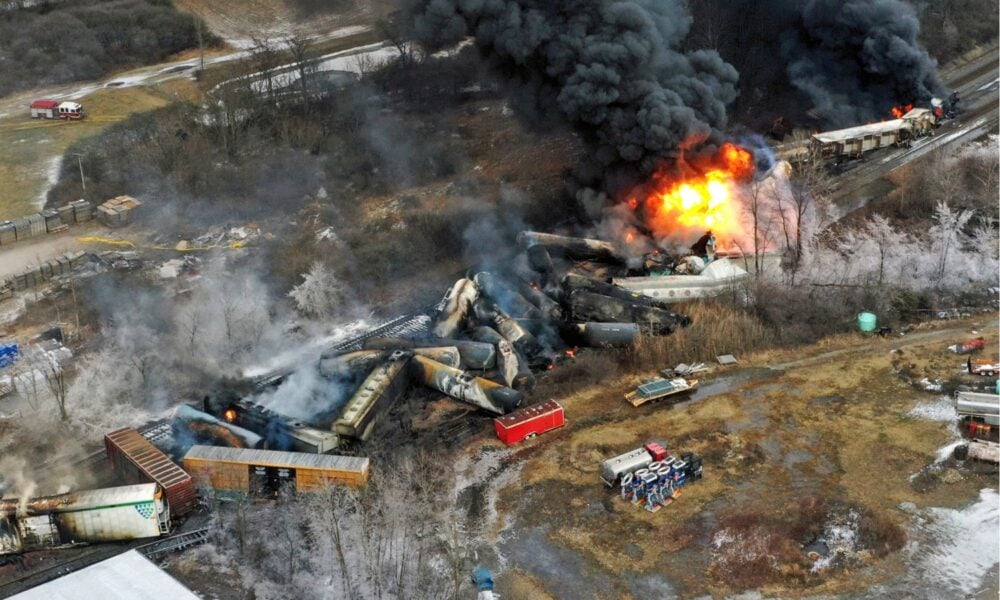Two years ago, a 149-car train transporting flammable hazardous chemicals derailed from the tracks near the town of East Palestine, Ohio, causing an explosion that burned for days. When the substances on the train burned, it emitted several highly toxic substances into the air, including vinyl chloride and butyl acrylate.
The US Environmental Protection Agency (EPA) stepped into action, working with state agencies to conduct air, water, and soil sampling throughout the community. Local officials also conducted a “controlled burn” of remaining vinyl chloride, purportedly to reduce the risk of additional explosions. Despite reassurances that there were no immediate public health hazards, residents of the town reported experiencing headaches, respiratory and gastrointestinal issues, stress, and skin irritation.
It wasn’t until more than a year later that community members started to get answers. In May 2024, a whistleblower report revealed that an EPA employee directed the agency’s contractor to falsify records related to air sampling of vinyl chloride and EPA conducted airborne monitoring over the disaster site in a way that appeared to avoid locations with potentially higher concentrations. The whistleblowers concluded that the community’s air, water, and soil were still contaminated. Then the following month, the chair of the National Transportation Safety Board (NTSB), Jennifer Homedy, shared in a public meeting that the agency’s investigation showed that the controlled burn, which emitted additional cancer-causing pollution in the air, was unnecessary. NTSB investigators also concluded that Norfolk Southern, the company that operated the derailed train, repeatedly tried to interfere with the investigation.
Eventually, the company agreed to a $310 million settlement with the federal government for Clean Water Act violations and to cover the costs of a cleanup and water and health monitoring programs in the community. The are several other settlements pending legal actions brought forward by impacted residents.
Promises kept, or empty promises?
Vice President JD Vance (then a US Senator from Ohio) strongly criticized the federal government’s response efforts. On Monday, EPA Administrator Lee Zeldin visited East Palestine with the Vice President, stating that “This administration will fight hard to make sure every American has access to clean air, land, and water.”
Just a few weeks into this administration, these promises are being undermined. EPA employees, including those that oversee hazardous waste cleanup, are being pushed out of the agency. Federal health agencies continue to be barred from publishing scientific research and the fate of National Institutes of Health (NIH) grant committees hangs in the balance. Last year, the National Institute of Environmental Health Sciences (NIEHS), which operates under NIH, awarded six research grants to study the health impacts of the disaster on East Palestine residents. The federal government must continue investing in these efforts for researchers to understand the long-term health effects, but the administration’s actions have so far pointed toward disinvestment and sidelining the work of the NIH and other health agencies.
Furthermore, communities in East Palestine do not have health care guidance or funding to ensure access to health care services. The President has the authority to declare a state of emergency and authorize federal assistance to the community through the Stafford Act, but so far there is no word on whether President Trump will do so.
The administration can also prevent these disasters from happening in the future by strengthening railroad safety regulations, including implementing recommendations made in NTSB’s report following the disaster. During Trump’s first term, the administration rolled back rail safety measures, including provisions that required rail cars carrying hazardous flammable materials to install more effective braking systems. If Vance is serious about preventing these disasters in the first place, then the administration will support stronger regulations to improve rail safety.
Chemical disaster regulations under threat
Last week, a number of industry trade associations sent a letter to Administrator Zeldin calling for a meeting to ask that the EPA roll back provisions in the Safer Communities by Chemical Accident Prevention rule, which was finalized last year to strengthen Risk Management Program (RMP). The RMP requires roughly 12,000 hazardous chemical facilities nationwide to implement measures to prevent and respond to catastrophic chemical disasters. Rolling back the updated rule would be in direct opposition to Zeldin’s promises to East Palestine residents.
While RMP regulations largely focus on stationary sources—such as chemical manufacturing facilities—they are part of the larger puzzle of hazardous chemical production in the U.S. Trains like the one that derailed in East Palestine are often transporting hazardous substances manufactured at facilities regulated under the RMP. And the updated regulations require some RMP facilities to evaluate whether safer chemicals and processes can be used instead. If implemented, it could mean that some of the most dangerous facilities transition to using safer chemicals, which in turn, may reduce the risks of catastrophic disasters when these materials are transported. Yet this is one of the provisions that the industry letter asks EPA to reconsider.
According to the Coalition to Prevent Chemical Disasters’ chemical incident tracker, there have already been nine chemical incidents in the U.S. in 2025, one of which was due to a train derailment in Oregon. If Vice President Vance intends to stand by his promises to East Palestine communities, he needs to consider the whole picture—and push his administration to reverse course. Communities deserve protection from catastrophic chemical disasters, whether they’re happening on the railroad or at a stationary facility. Gutting the rules—and pushing out the EPA employees that enforce them—is nothing short of a betrayal.

